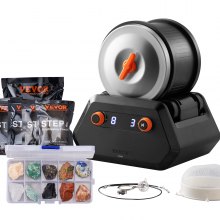VEVOR Rock Tumbler Kits: Your Gateway to Polished Perfection
Machines called rock tumblers are used to polish and smooth rocks. They are a common instrument enthusiasts use in jewelry-making, crafts, and lapidary to create tumbling stones. Those who wish to uncover the hidden treasures of minerals and rocks are also drawn to the activity of rock tumbling.
It's a satisfying feeling to take an unpolished bit of rock and turn it into a gorgeous stone for jewelry. VEVOR kits combine cutting-edge technology, precise engineering, and a dash of artisanal refinement to create a seamless combination that makes them more than just tools.
How Do Rock Tumblers Work?
The barrels of the most often used tumblers are filled with abrasive grit, water, and pebbles. The granular substance known as abrasive grit is comparable to the grains that are adhered to sandpaper.
Gritters are frequently categorized as "coarse," "medium," and "fine," just like sandpaper comes in different grades. The rocks inside the barrel tumble as it is rotated by a motorized mechanism that holds it filled with grit, water, and rocks.
Fragments of the abrasive grit get stuck between the falling boulders as they grind against each other. This process smooths the surfaces of the rocks and wears off their sharp edges. These kinds of tumblers are referred to as "rotary tumblers."
Usually, the rocks are tumbled for one or a couple weeks in coarse grit, a week in medium grit, and a week in fine grit. The rocks and barrel are thoroughly cleaned between each grit size.
After that, the rocks are tumbled with water and rock polish for one last week. The rocks are typically turned into brilliantly polished stones after this process.
What Type of Rocks Can Be Tumbled?
Most rocks won't work well in a rock tumbler, but a novice can successfully tumble a few different kinds of rocks with careful selection. These easily tumbled rocks consist of petrified wood, chalcedony, jasper, and agate.
Microcrystalline quartz, which is extremely hard, resilient, and long-lasting and takes a very bright polish, makes up all these materials. No cavities, voids, or fractures are present in rocks that are valuable for tumbling.
They don't have a granular texture, either. Many people are fortunate enough to reside where it is possible to gather these rocks from streams, beaches, or the earth itself—always with the owner's consent.
If you don't reside in one of these areas, you can still get quality tumbler material from a rock store or online company offering rock tumblers and other tumbler accessories.
Types And Sizes of Rotary Tumblers
Rock tumblers come in a variety of sizes to suit a variety of applications. Below is a description of the three fundamental categories.
Toy Rock Tumblers
Toy tumblers with a body made of plastic and a barrel are the smallest and least costly type of tumblers. Usually, these machines retail for $40 to $80 online or at nearby craft and toy stores. These machines have the benefit of being inexpensive.
The noise produced by the rocks tumbling in the plastic barrel is a frequent complaint about toy rock tumblers; however, they barely tumble a few grams of very small rocks and don't last very long until they wear out.
Hobbyist Rock Tumblers
Hobby tumblers usually retail for between $70 and $300, mostly according to size. Most have a sturdy metal frame and a high-quality motor meant to last many years.
They function silently since they have a rubber-lined metal barrel or a rubber-lined metal barrel. Usually, they fall between two and ten pounds of stone.
The first hobbyist tumblers appeared in the late 1950s. The fundamental designs of two brands—Lortone and Thumler's Tumblers—remain mostly unchanged and are still produced today.
Products that are successful stay on the market. Many people who were given a hobbyist tumbler by Lortone or Thumler's as a youngster still use it with their grandchildren!
Commercial Rock Tumblers
Large devices known as commercial tumblers can turn from a few dozen to several thousand pounds of rock simultaneously.
They are virtually exclusively utilized by individuals and businesses engaged in the production of tumbled stones, and their costs range from a few hundred to several thousand dollars.
Why Choose VEVOR Rock Tumbler Kits?
Upgrade your lapidary projects with VEVOR Rock Tumbler Kits, an example of unparalleled accuracy and craftsmanship. Designed for pros and hobbyists, these kits combine state-of-the-art technology with an obsession with excellence.
VEVOR is a leader in innovation, providing sturdy tumblers that turn unpolished stones into elegant works of art. Longevity and whisper-quiet operation are guaranteed by the careful engineering and sturdy materials.
VEVOR Rock Tumbler Kits are the discerning option for individuals who demand perfect results and an extra dose of refined elegance, regardless of your level of experience or desire for the highest level of performance.
FAQs About Rock Tumbler Kits
What comes in a rock tumbler kit?
A standard rock tumbler kit consists of the tumbler itself, one or more barrels, coarse, medium, fine, and polish abrasive grit, and occasionally a selection of rocks to get you started.
How noisy are rock tumblers?
While rock tumblers can make some noise, it's usually not too much. Reviewing the specifications of the particular tumbler kit you are contemplating is recommended, as the noise level differs between models.
How long does it take to tumble rocks?
Depending on the ideal level of polish and the hardness of the rocks, the tumbling process might take several weeks, usually three to six weeks. There's a time requirement for each level of grit.
Is there maintenance required for a rock tumbler?
Cleaning the barrel, inspecting the seals, and ensuring the engine operates correctly are all routine maintenance. It is important to maintain in accordance with the manufacturer's instructions.



























































































































